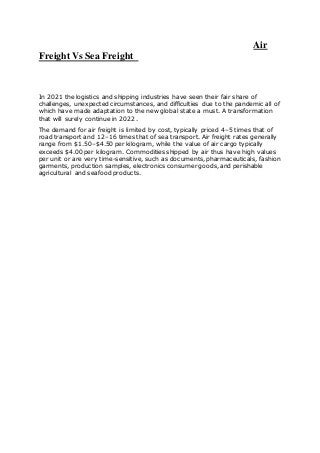
Air Freight Vs Sea Freight.docx
- 1. Air Freight Vs Sea Freight In 2021 the logistics and shipping industries have seen their fair share of challenges, unexpected circumstances, and difficulties due to the pandemic all of which have made adaptation to the new global state a must. A transformation that will surely continue in 2022. The demand for air freight is limited by cost, typically priced 4–5 times that of road transport and 12–16 times that of sea transport. Air freight rates generally range from $1.50–$4.50 per kilogram, while the value of air cargo typically exceeds $4.00 per kilogram. Commodities shipped by air thus have high values per unit or are very time-sensitive, such as documents, pharmaceuticals, fashion garments, production samples, electronics consumer goods, and perishable agricultural and seafood products.
- 4. They also include some inputs to meet just-in-time production and emergency shipments of spare parts. In the short run, higher fuel prices are expected to result in slower growth of air cargo traffic or even in a possible downturn. The choice depends on the needs and requirements of the customers. It has been observed that sea cargo is very much more affordable than air freight. Just like air freight is the quickest way possible, ocean freight is the cheapest way of transporting goods. Both air freight and ocean freight have their own advantages and disadvantages so they can’t replace each other. It's essential to keep an eye on the air and ocean markets as both are highly volatile. In many cases, depending on how market rates are moving and other market dynamics, one mode of transport can be chosen over the other. Real- time and on-demand ocean freight rates data allows professionals to react instantaneously and make the right decision that positively impacts the bottom line.